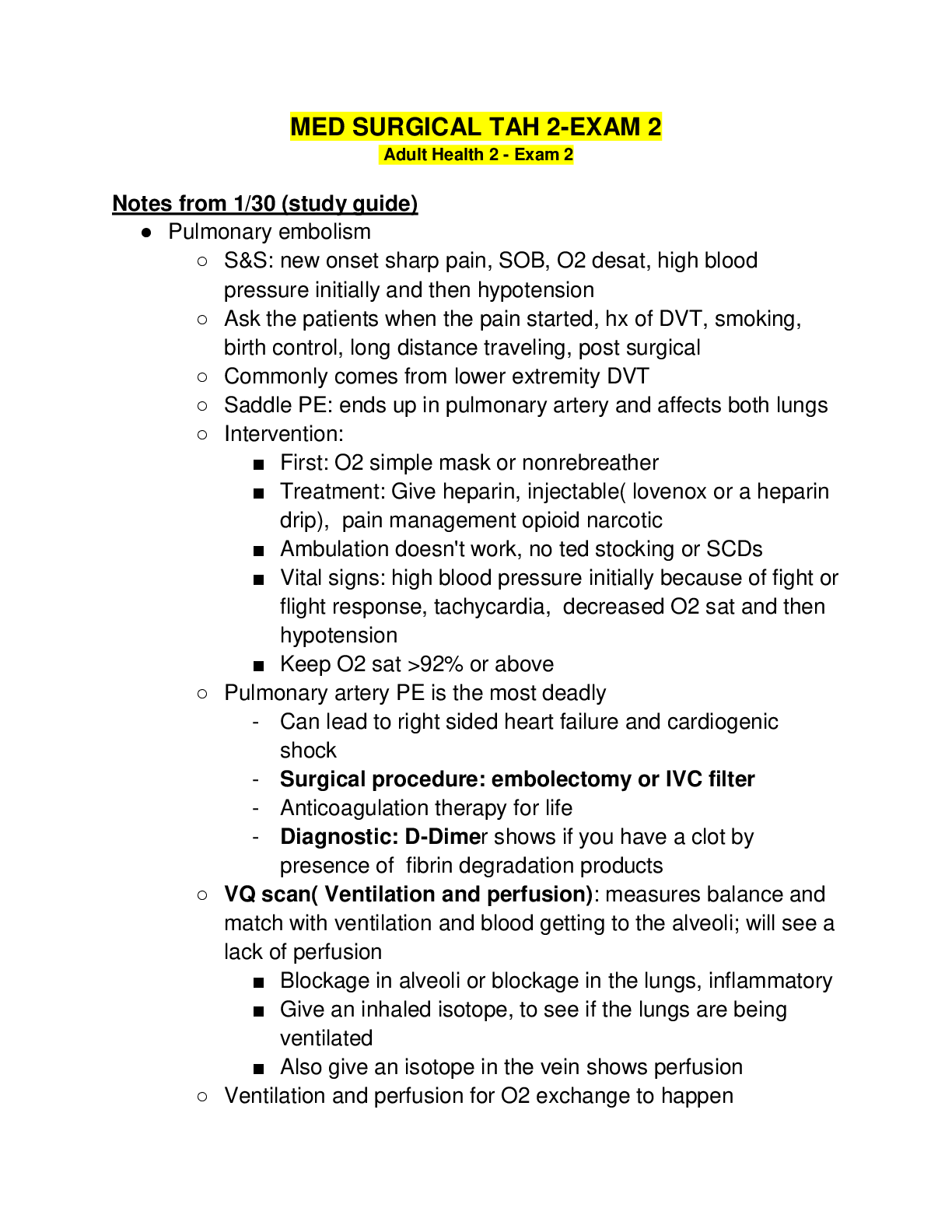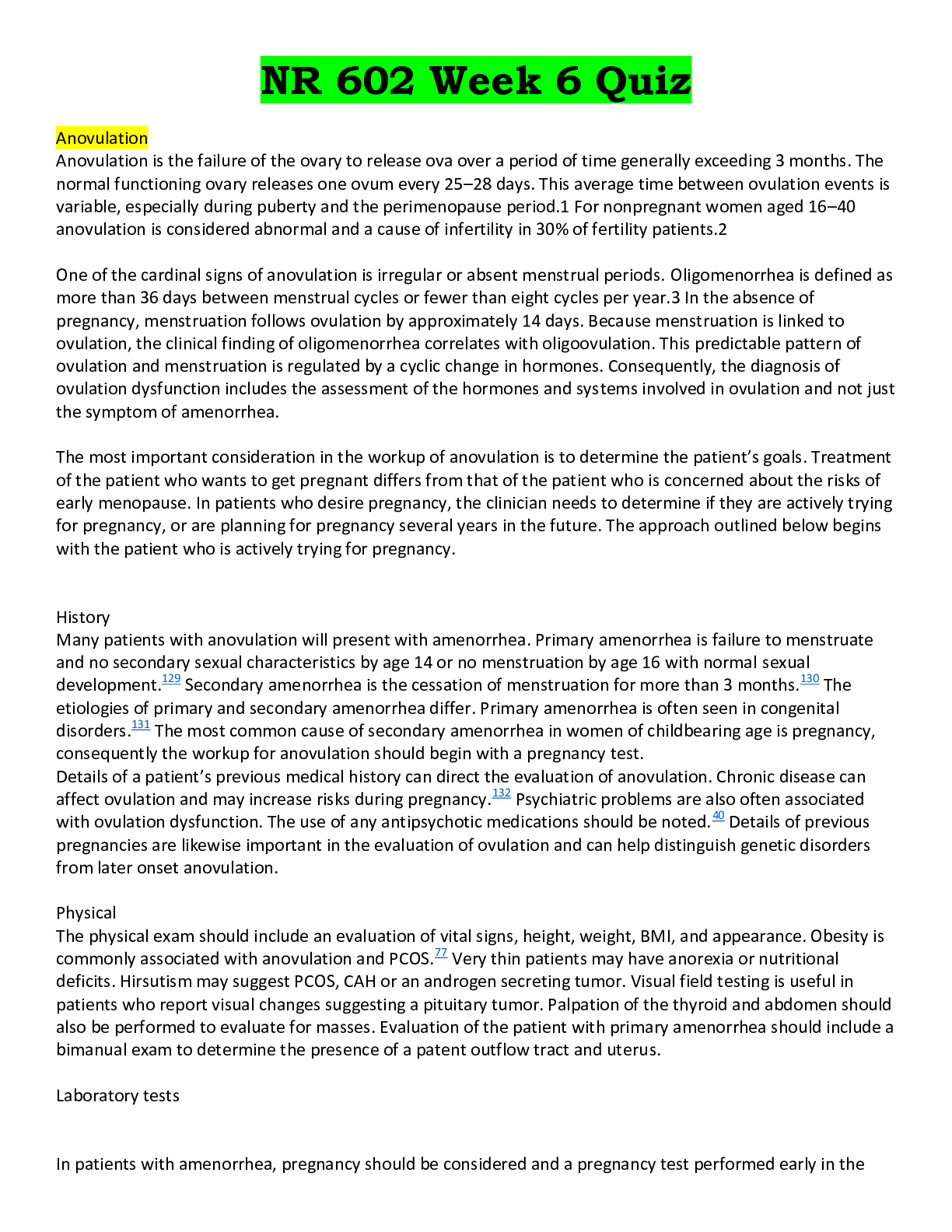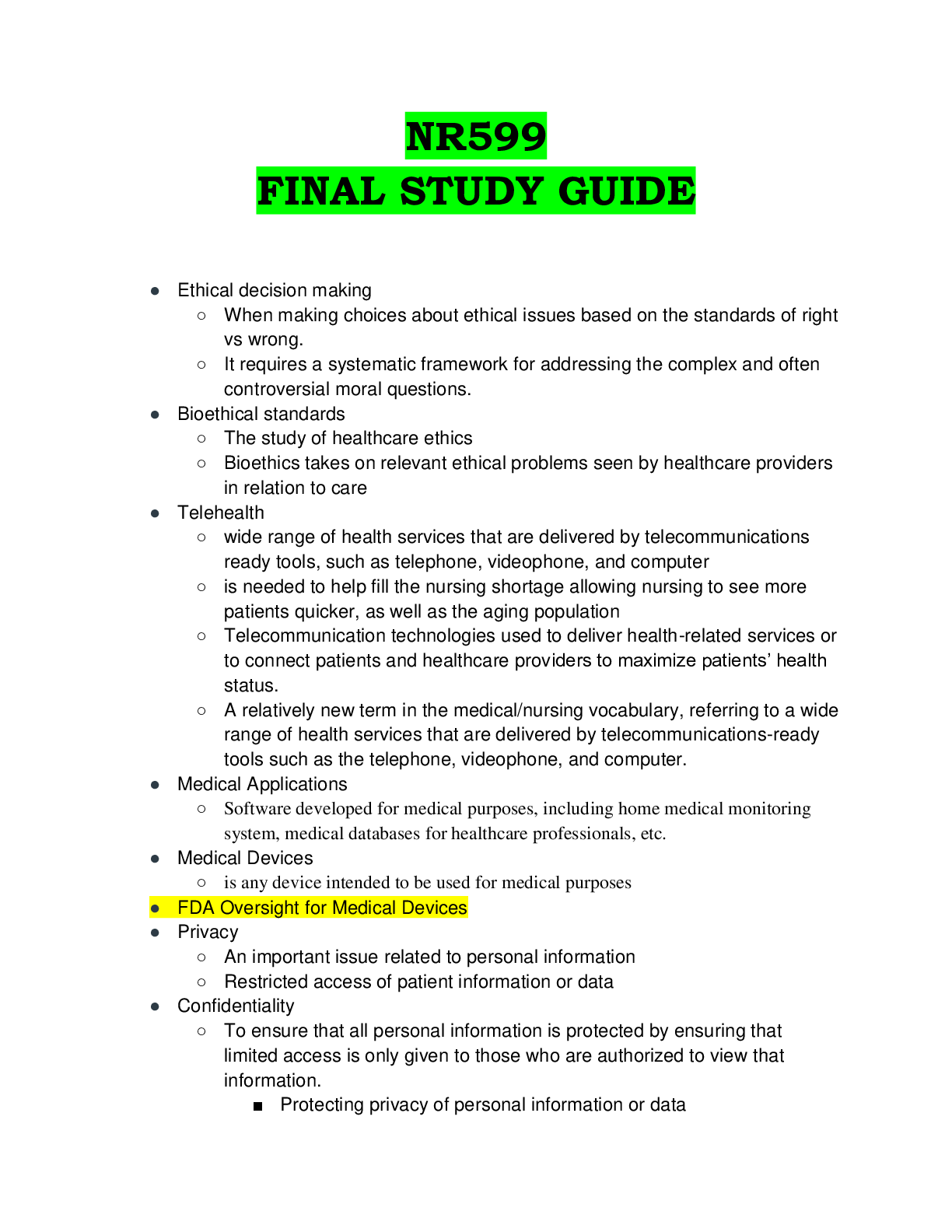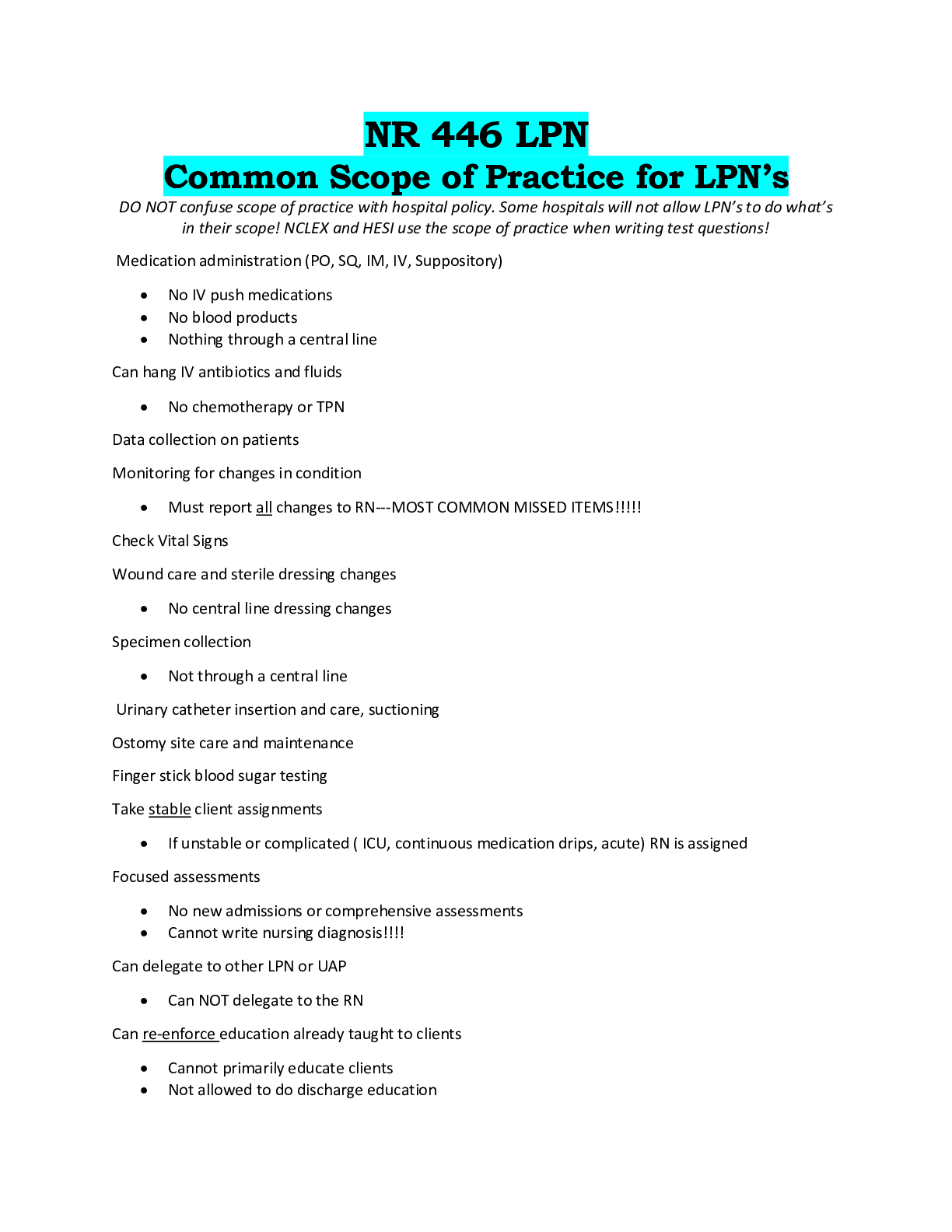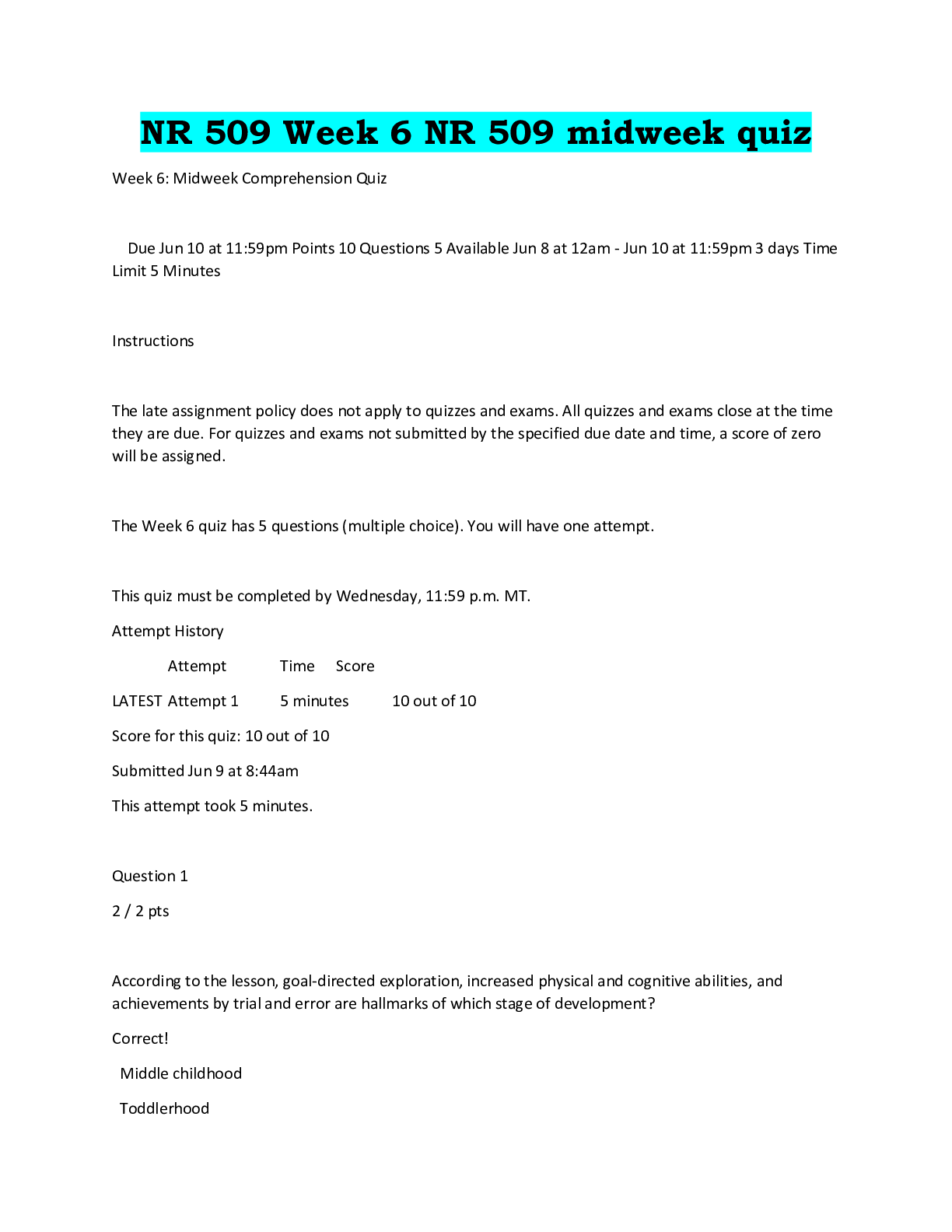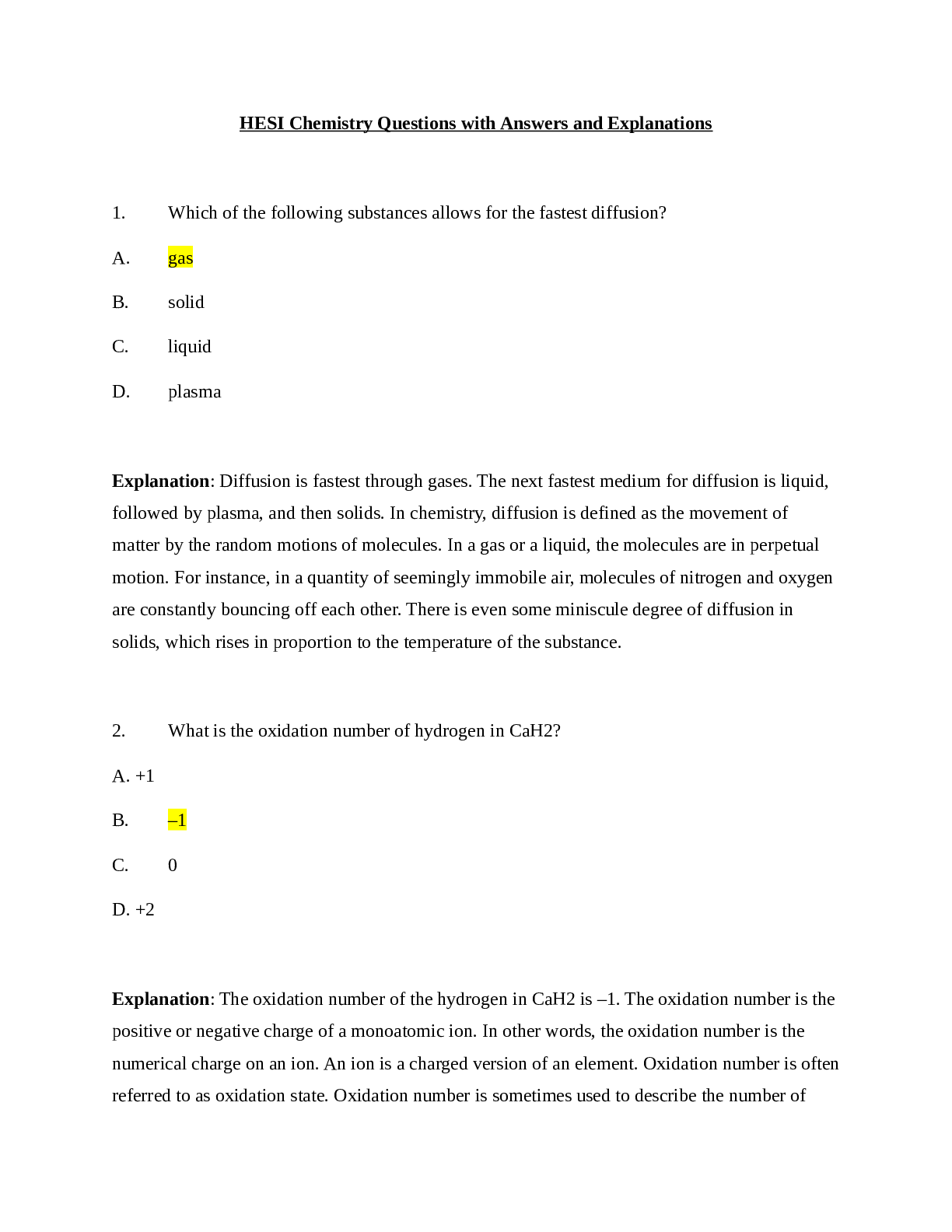*NURSING > EXAM REVIEW > NURS 326 fundamentals test 2 with answers and Rationale (All)
NURS 326 fundamentals test 2 with answers and Rationale
Document Content and Description Below
NURS 326 fund test 2 Question 1 2.5 / 2.5 pts 1. What is the primary difference between acute and chronic wounds? Chronic wounds: A. Result from pressure, but acute wounds result from surgery B. ... Are full thickness wounds, but acute wounds are superficial C. Are usually infected, whereas acute wounds are contaminated Correct! Exceed the typical healing time, but acute wounds heal quickly The length of time for healing is the determining factor when classifying a wound as acute or chronic. Acute wounds are expected to be of short duration. Wounds that exceed the anticipated length of recovery are classified as chronic wounds. The length of time for healing is the determining factor when classifying a wound as acute or chronic. Acute wounds are expected to be of short duration. Wounds that exceed the anticipated length of recovery are classified as chronic wounds. Question 2 2.5 / 2.5 pts A patient has a wound that extends through the epidermis into the dermis, but not past the dermis. When documenting the depth of the wound, how would the nurse classify it? Correct! Partial thickness wound Partial thickness wounds extend through the epidermis into the dermis. Superficial wounds involve only the epidermis. Full thickness wounds extend into the subcutaneous tissue and beyond. Penetrating wound Superficial wound Full-thickness wound Partial thickness wounds extend through the epidermis into the dermis. Superficial wounds involve only the epidermis. Full thickness wounds extend into the subcutaneous tissue and beyond. Question 3 2.5 / 2.5 pts A patient underwent abdominal surgery for a ruptured appendix. The surgeon did not surgically close the wound. The wound healing process described in this situation is: Correct! Secondary intention Secondary intention healing occurs when a wound is left open, and it heals from the inner layer to the surface by filling in with beefy, red granulation tissue. Primary intention healing occurswhen a wound is surgically closed. Tertiary intention healing occurs when a wound that was previously left open to heal by secondary intention is closed by joining the margins of granulation tissue. Primary intention Tertiary intention Approximation healing Question 4 2.5 / 2.5 pts When teaching a patient about the healing process of an open wound after surgery, which of the following points would the nurse make? Because the patient's wound was left open, the wound will likely become infected The patient will need to take antibitoitcs until the wound is completely healed Correct! The patient will have more scar tissue formation than there would be for wound closed at surgery Because wound edges are not approximated, more scar tissue will form. Although open wounds are more prone to infection, this is not an expected outcome, and antibiotics would not necessarily be needed. A patient with an open wound should not expect an extended hospital stay if wound care can be provided in the home or an outpatient setting. Question 5 2.5 / 2.5 pts Pressure ulcers are directly caused by which of the following conditions at the site? Dryness Edema Inadequate venous return Correct! Compromised blood flow Pressure ulcers are caused by unrelieved pressure that compromises blood flow to an area, resulting in ischemia (inadequate blood supply) in the underlying tissues. Friction and shear are extrinsic factors, which increase the risk of a client developing a pressure ulcer but is not the direct cause of etiology, nor is dryness. Inadequate arterial blood flow to an area as a result of pressure causes the development of a pressure ulcer. Edema leads to compromised skin and tissue integrity, which is more prone to pressure injury. Question 6 2.5 / 2.5 pts A patient hospitalized in a long-term care facility is immobile and requires mechanical ventilation with a tracheostomy. The client has a pressure ulcer on her sacrum measuring 5cm by 3cm. The area is 100% covered by eschar. What stage would the nurse identify for this pressure ulcer? Stage IICorrect! Unstageable pressure ulcer An eschar is black, leathery covering made up of necrotic tissue. An ulcer covered in eschar cannot be classified or staged using a staging method because it is impossible to determine the depth of the wound and to visualize the wound bed. Stage III Stage IV Question 7 2.5 / 2.5 pts A patient had a CVA (stroke) 2 days ago, resulting in decreased mobility to the left side. During assessment, the nurse discovers a stage I pressure ulcer on the left heel. What is an initial action by the nurse to prevent progression to stage II ulceration? Normal saline irrigation to the wound be daily Debridement of the wound bed of the heel Correct! Elevation of the heel off the bed Pressure ulcers are caused by pressure to an area that restricts blood flow, causing ischemia to underlying tissue. The primary treatment is to relieve the pressure, thus improving blood flow. Elevating the patient's heel off the bed would relieve the pressure. Antibiotics treat infection; this wound is not infected. Skin of a stage I pressure ulcer is intact but has non-blanceable reddness, therefore irrigation is not indicated for stage I. The area may be painful, firm, soft or warmer or cooler as compared with adjacent tissue, but it is not deep enough for debridement. Question 8 2.5 / 2.5 pts What client does the nurse recognize as being at greatest risk for pressure ulcers? Infant with skin rash in diaper area Older adult requiring use of walker for ambulation Correct! Middle-aged adult who is paralyzed and bedridden The client at greatest risk the client with impaired sensation from paralysis and is experiencing immobility due to being bedridden. The infant with disruption to the skin from diaper rash is at risk for infection, but not for pressure ulcer development. The young adult with diabetes is at increased risk for delayed wound healing but not likely for a pressure ulcer because he or she would shift weight in bed on own. The older adult is normally at risk for pressure injury, but when mobile, even with an assistive device, the risk is minimal. Question 9 0 / 2.5 pts When making an occupied bed, which of the following is most important for the nurse to do? Correct AnswerUse a bath blanket or sheet to maintain privacy and warmth When making an occupied bed, the nurse should cover the patient with a bath blanket or sheet. Covering the patient prevents chilling and preserves modesty. Keeping the bed in the low position and working over raised side rails may strain the nurse's back. Continually moving from side to side is disorganized and time consuming. Question 10 2.5 / 2.5 pts The nurse is teaching a nursing assistant how to give a complete bed bath. Which instruction should the nurse include? "Cleanse only the areas that are likely to cause odor." "Provide the patient cold water for them to bathe themselves." Correct! "Bathe the patient from head to toe, cleanest areas first." The nurse should instruct the NA to give a complete bed bath is a head-to-toe manner. Begin with the cleanest part of the body and ending with the dirtiest. Warm water is used for bathing, not cold. All areas should be cleaned during the bath, no exceptions. Question 11 2.5 / 2.5 pts What is the most frequent cause of the spread of infection and microorganisms among hospitalized patients? Contact with contaminated equipement Correct! Hands of healthcare workers Patients are exposed to microbes by contact (direct, airborne, or otherwise) with other patients, family members, and contaminated healthcare equipment. Some of these are pathogenic (cause illness) and some are not pathogenic (do not cause illness). But most microbes causing infection among patients are spread by direct contact on the hands of healthcare workers. Question 12 2.5 / 2.5 pts A patient is admitted with tuberculosis. Which precautions must the nurse institute when caring for this patient? Droplet transmission Direct contact Indirect contact Correct! Airborne transmission The organisms responsible for tuberculosis are spread through airborne transmission. Question 132.5 / 2.5 pts A patient develops localized heat and erythema over an area on the lower leg. These findings are indicative of which secondary defense against infection? Phagocytosis Complement cascade Immune response Correct! Inflammation The classic signs of inflammation , a secondary line of defense, are erythema and localized heat. The secondary defense of phagocytosis and the complement cascade do not produce these visible signs. Immunity is a tertiary line of defense for the body. Question 14 2.5 / 2.5 pts Which of the following protect(s) the body against infection by enhancing the body's own defenses? (Select all that apply) Correct! Managing stress Correct! Exercising regularly Being an older adult or infant Correct! Eating a healthy well-balanced diet Question 15 2.5 / 2.5 pts The nurse is teaching a group of new nursing assistants about proper handwashing. The nurse will know that the teaching has been effective if the nursing assistant demonstrates which of the following? (Select all that apply) Correct! Uses a paper towel to turn off the faucet Handwashing requires at least 15 seconds of washing, which includes lathering of all surfaces of the hands and fingers to be effective. The fingers should be held lower than the wrists when rinsing. Holds fingertips above the wrist while rinsing the soap off Correct! Cleans underneath each fingernail Correct! Removes all rings before washing hands Question 16 2.5 / 2.5 ptsThe nurse understands which procedure should be implemented for a patient on droplet based transmission precautions? Correct! Wear appropriate PPE, including face mask, when contact or exposurse is anticipated in a 3- foot range of the patient per agency policy The patient on droplet based precautions is considered infectious within a 3-foot range. PPE should be worn per policy when the nurse is providing care, including a face mask. A respirator is required for work with this patient Gloves are not need for this patient This patient should be in a negative pressure room The patient on droplet based precautions is considered infectious within a 3-foot range. PPE should be worn per policy when the nurse is providing care, including a face mask. Question 17 2.5 / 2.5 pts What is a fomite? A rare virus Correct! A contaminated object A flying insect that bites A mouse with small teeth Definition Question 18 2.5 / 2.5 pts The nurse understands the body's first line of defense against infection is: Vaccination Correct! Skin Immunity Inflammation Question 19 2.5 / 2.5 pts The nurse understands which patients are at increased risk of delayed or poor wound healing? (Select all that apply) Correct! Immunocompromised FemalesCorrect! Malnourished Correct! Diabetics Correct! Young and elderly Question 20 2.5 / 2.5 pts The nurse is documenting wound assessment on a surgical wound that is healing by primary intention. Which documentation is appropriate? The wound bed is visible with pink color and yellowish clear drainage. Wound depth 2 centimeters. Correct! The wound edges are well approximated, with staples intact, and no reddness or erythema noted. 3 centimeter by 5 centimeter wound on sacrum, with dark red colored eschar noted. Unstageable wound on left heel, 3 centimeters by 5 centimeters, foul odor noted Question 21 2.5 / 2.5 pts The nurse uses a universal approach to all patients with each skill performed. Which is not a universal approach to use? Nurse introduction Correct! Administering presribed pain medication Hand hygiene Client identification Each is a universal intervention except pain medication. Not all patients require this. Question 22 2.5 / 2.5 pts When preparing a sterile field, the nurse understands which principle to be correct? Correct! The 1 inch border of the sterile field is considered to be contaminated Sterile gloves are used for taking vital sign each time Any sterile procedure should never exceed 3 minutes Sterile field is only used in the operating room The sterile field has a contaminated one inch border, always. The other answers are incorrect and not true. Question 232.5 / 2.5 pts The nurse in the emergency department admits a patient with a gunshot wound to the lower abdomen that occurred 15 minutes ago and is accompanied by heavy bleeding. What type of drainage does the nurse expect to see on the wound dressing? Correct! Sanguineous Serosanguineous Serous Purulent A GSW that occured within the last 15 minutes with heavy bleeding would have sangineous drainage. Question 24 2.5 / 2.5 pts When assessing a wound, the nurse notes watery, clear-pinkish drainage. How should the nurse describe this type of drainage? Sanguineous Correct! Serosanguineous Purulent Serous Serosanguineous is watery, reddish to pinkish, yellow drainage. Question 25 2.5 / 2.5 pts Which are important to document when assessing a wound? (Select all that apply) Correct! Location Correct! Size Correct! Drainage Correct! Odor All are correct Question 26 2.5 / 2.5 pts While applying a wet-to-dry dressing how would the nurse explain to the patient the process for how this helps the wound? A wet-to-dry dressing is:You Answered A form of debridement that uses an occlusive, moisture retaining dressing to break down necrotic tissue A procedure that uses proteolytic agents to break down necrotic tissue in the wound bed A method of submerging the wound in water, allowing it to soak before drying the wound bed Correct Answer A means of debriding the wound but also removing granulation tissue from the wound The wet to dry process provides for degranulation of the wound bed. Question 27 2.5 / 2.5 pts The nurse is documenting wound assessment on a surgical wound that is healing by primary intention. Which documentation is appropriate? The wound bed is visible with pink color and yellowish clear drainage. Wound depth 2 centimeters. Unstageable wound on left heel, 3 centimeters by 5 centimeters, foul odor noted Correct! The wound edges are well approximated, with staples intact, and no reddness or erythema noted. 3 centimeter by 5 centimeter wound on sacrum, with dark red colored eschar noted. A wound healing by primary intention will have well approximated would edges. Question 28 2.5 / 2.5 pts The nurse is caring for a patient with an open wound. The patient has a nursing diagnosis label of Risk for Infection. What is an appropriate goal for this patient? Correct! Free of infection Antibiotics as ordered Increase caloric intake Free from scar tissue A patient goal should be the opposite of the nursing diagnosis. Question 29 2.5 / 2.5 pts The nurse knows the reservoir, as a link in the chain of infection, serves the purpose of: Passing the pathogen to the host Correct! Housing the pathogens to live and multiply Contaminating the hostProvides a route of movement for the pathogen A reservoir is where a pathogen lives and multiplies. Question 30 2.5 / 2.5 pts The nurse understands that diseases spread by droplet transmission are spread by: Needle sticks Sexual contact Correct! Coughing and sneezing Air and ventialtion system contamination Droplet based transmitted diseases are spread short distance through coughing and sneezing or contact with contaminated objects. Question 31 2.5 / 2.5 pts Which disease is spread through airborne transmission? Correct! Tuberculosis Gonorrhea AIDS Influenza TB is an airborne disease. Question 32 0 / 2.5 pts Which is a method used for strengthening the host and thus, weakening a link in the chain of infection? You Answered Instituting isolation precautions Limiting visitors Compression bandages Correct Answer Providing immunizations Immunizing a person is a method used to strengthen the host. Others are incorrect. Question 33 2.5 / 2.5 pts When an infection is latent, the nurse understands which is true? The infection has been eradicatedThe person has active signs of infection The person has not been infected yet Correct! The person is infected but without signs A latent infection is an infection that is present in a person, but there are no discernible signs or symptoms. Question 34 2.5 / 2.5 pts What is a characteristic of the body's second line of defense against infection? Intact skin Secretory immune function Correct! Inflammation Active T and B cels The inflammatory process is the body's second line of defense. Question 35 2.5 / 2.5 pts The nurse uses medical asepsis during a skill. What does this imply? The nurse must wear isolation PPE The procedure requires sterile technique The patient is in a special isolation room Correct! The technique is a clean technique Medical asepsis involves clean technique, not sterile technique. Question 36 2.5 / 2.5 pts A patient who is ordered to be on protective isolation is known to have compromised: Correct! Immune function Hemoglobin Range of motion Vision Protective isolation is for patients with compromised immune function. Question 37 2.5 / 2.5 ptsWhat is the proper order of injecting air into vials of insulin when administering both regular (clear) and NPH (cloudy) insulin? Inject air into the clear insulin, then the cloudy insulin Inject air only into the cloudy insulin Correct! Inject air into the cloudy insulin, then the clear insulin These two medications are never mixed Question 38 0 / 2.5 pts The nurse is assessing a patient for pain, the patient reports a pain level of 7 on a 0 to 10 scale. The nurse should: Ask the patient if they are sure they have that much pain You Answered Call the provider to request a pain management consult Correct Answer Assess for ojective signs of pain Recheck this rating in 30 minutes Question 39 2.5 / 2.5 pts The nurse is caring for a patient with a sensory deficit impacting hearing. What is an important assessment to make regarding home life before discharging the patient? Turning the temperature of the water heater down to a cool temperature Clearing all areas of the home from clutter Correct! Ensuring the patient has a visual cue from smoke alarms in addittion to sound Taping instructions for use of microwave on the appliance door Question 40 2.5 / 2.5 pts Which nursing actions are appropriate for the patient who is hearing impaired? (Select all that apply) Correct! Ensuring access to hearing aids if applicable Correct! Using a story board for written communication Correct! Enabling closed captioning on the television Using a loud voice when communicatingQuiz [Show More]
Last updated: 1 year ago
Preview 1 out of 13 pages
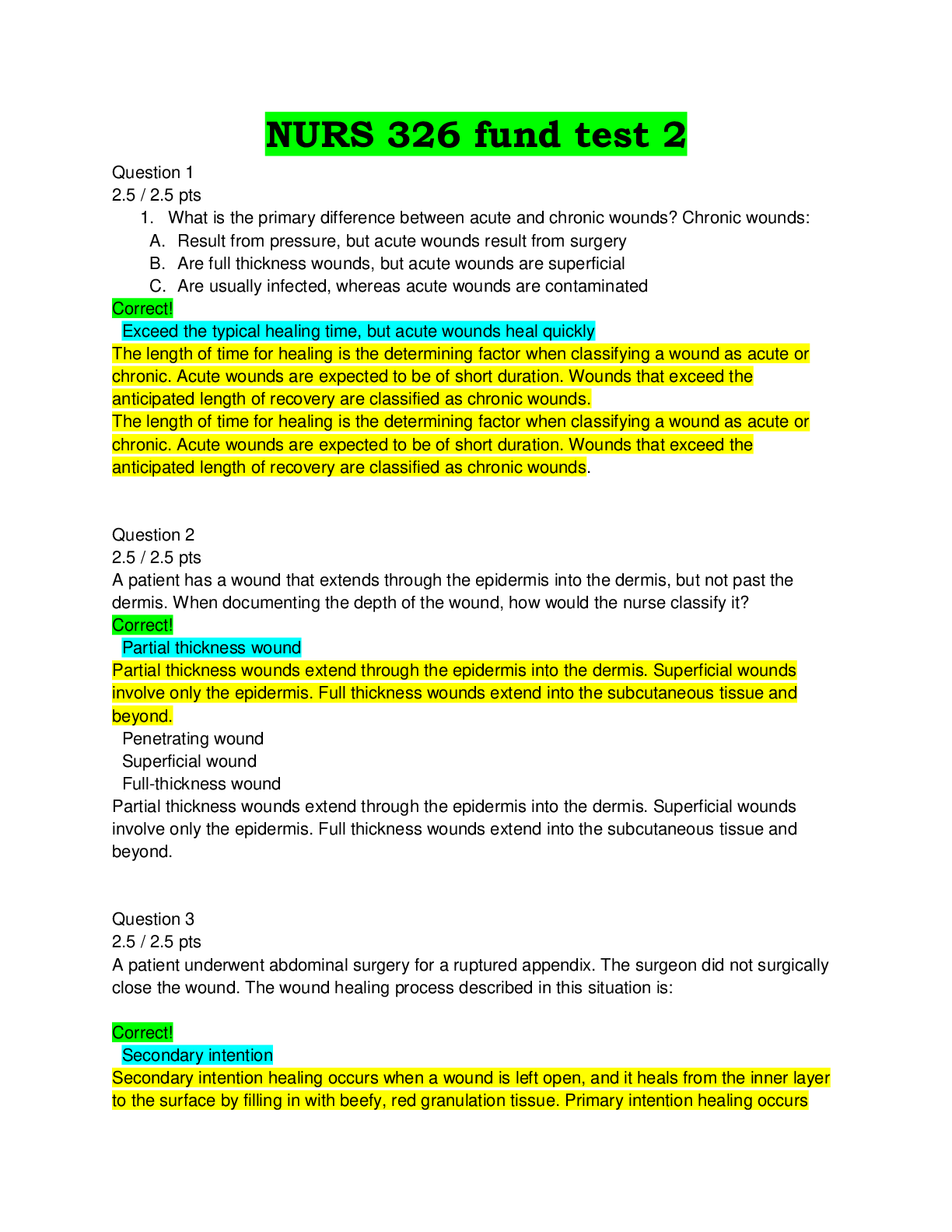
Buy this document to get the full access instantly
Instant Download Access after purchase
Add to cartInstant download
We Accept:

Reviews( 0 )
$7.00
Document information
Connected school, study & course
About the document
Uploaded On
May 16, 2021
Number of pages
13
Written in
Additional information
This document has been written for:
Uploaded
May 16, 2021
Downloads
0
Views
52

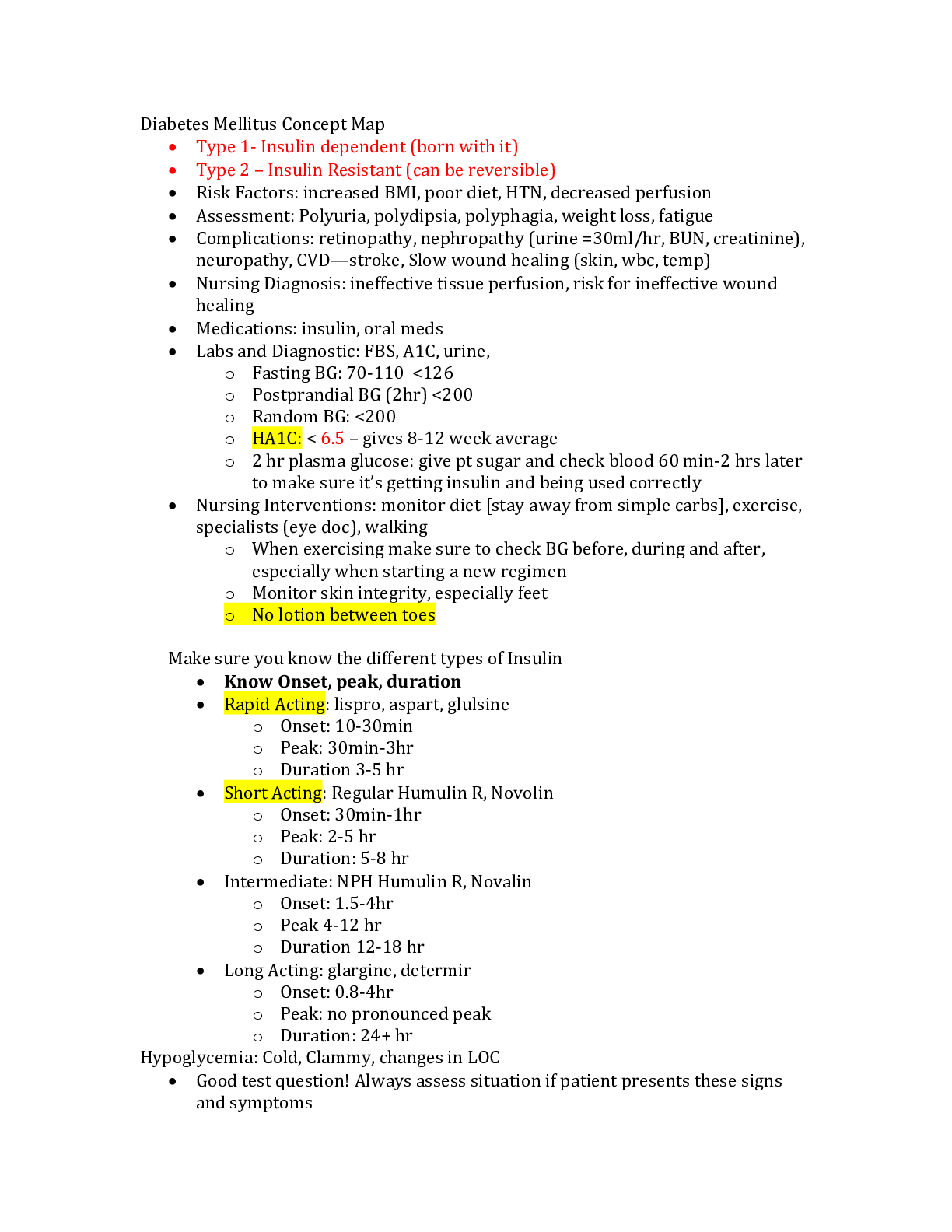
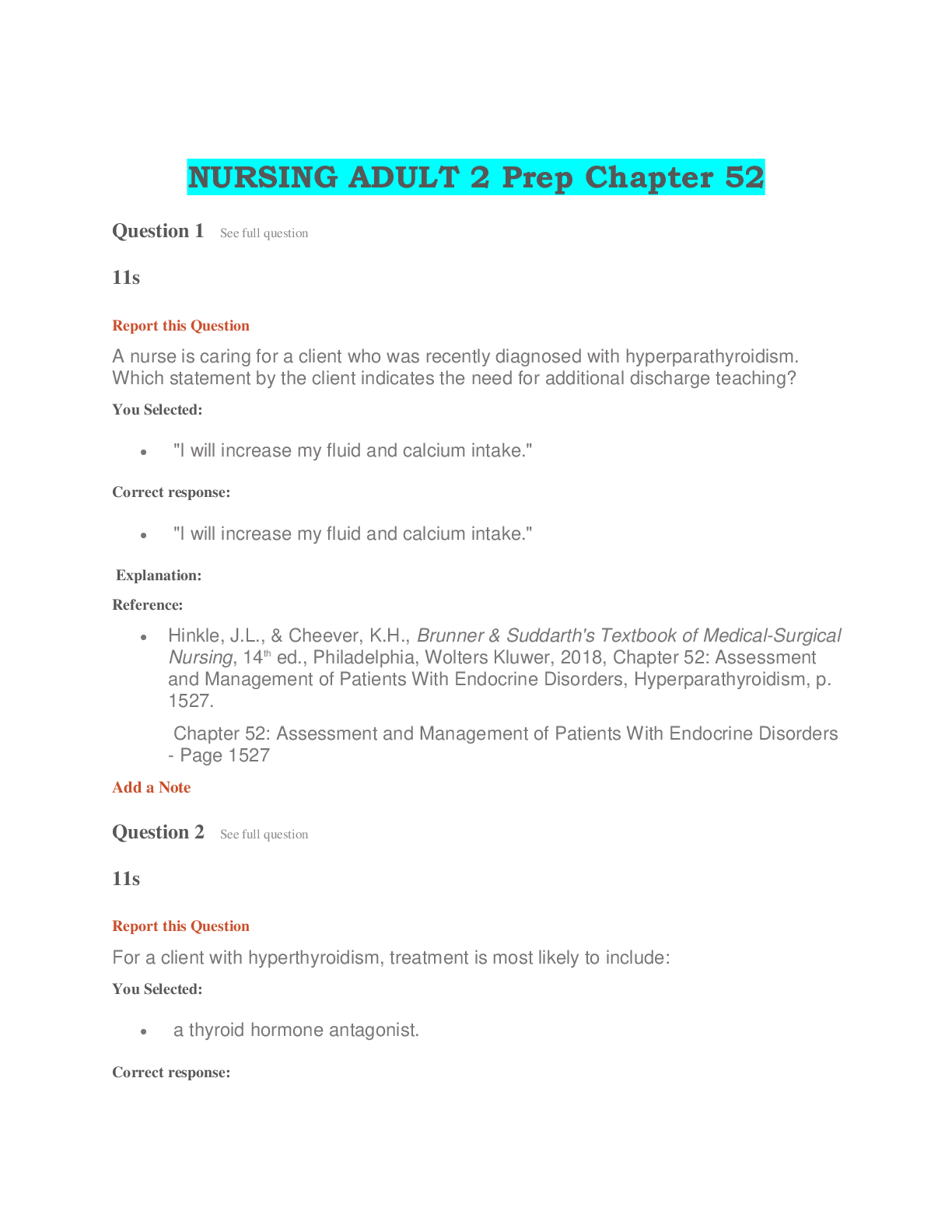
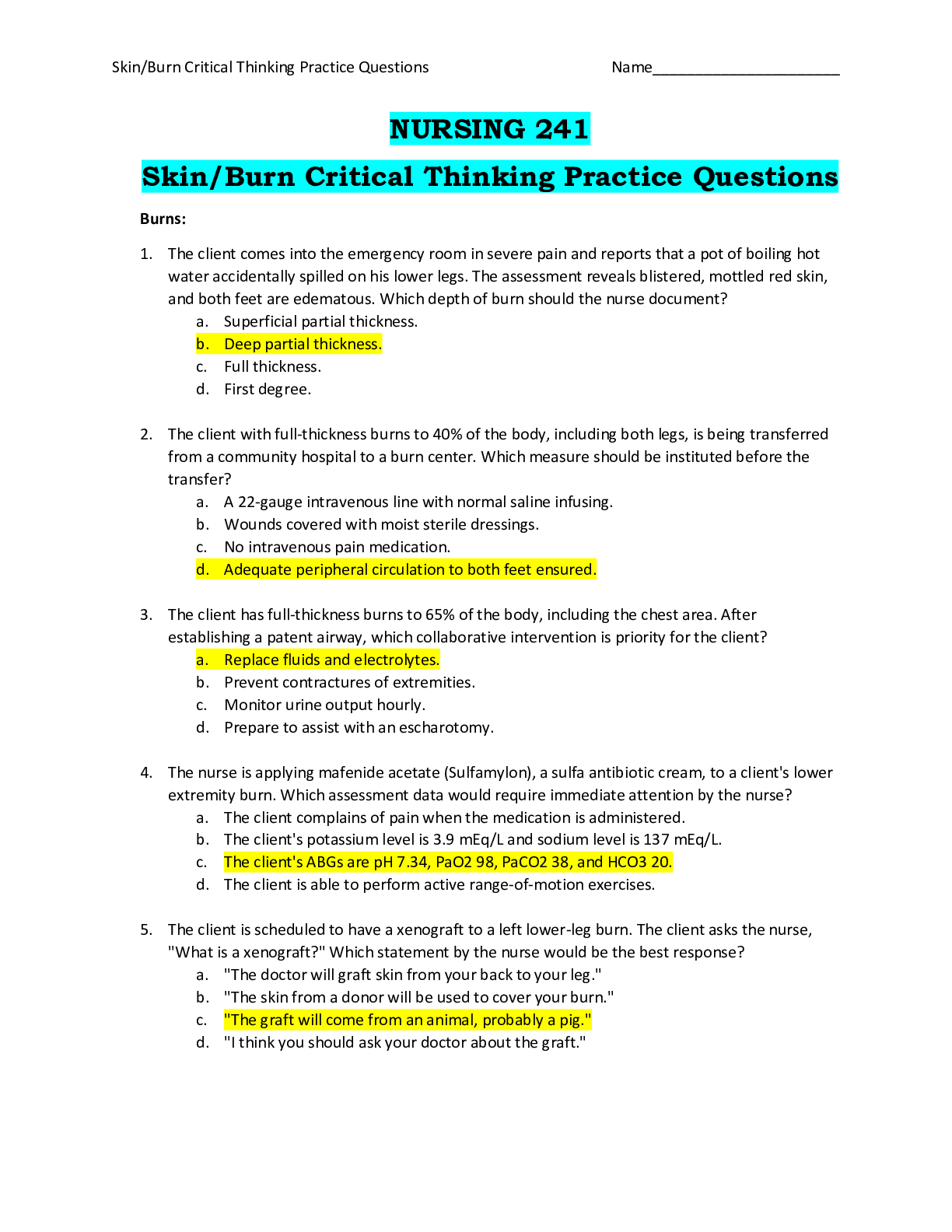
.png)
